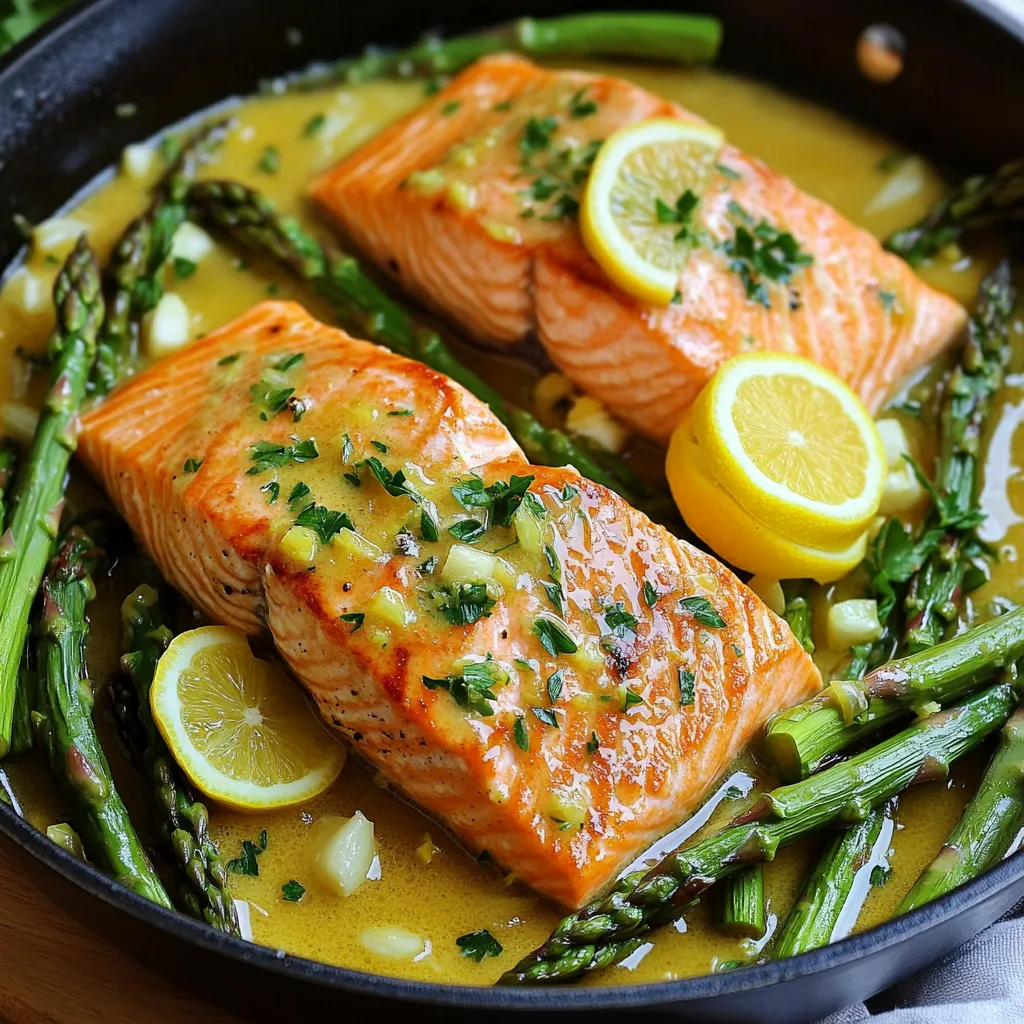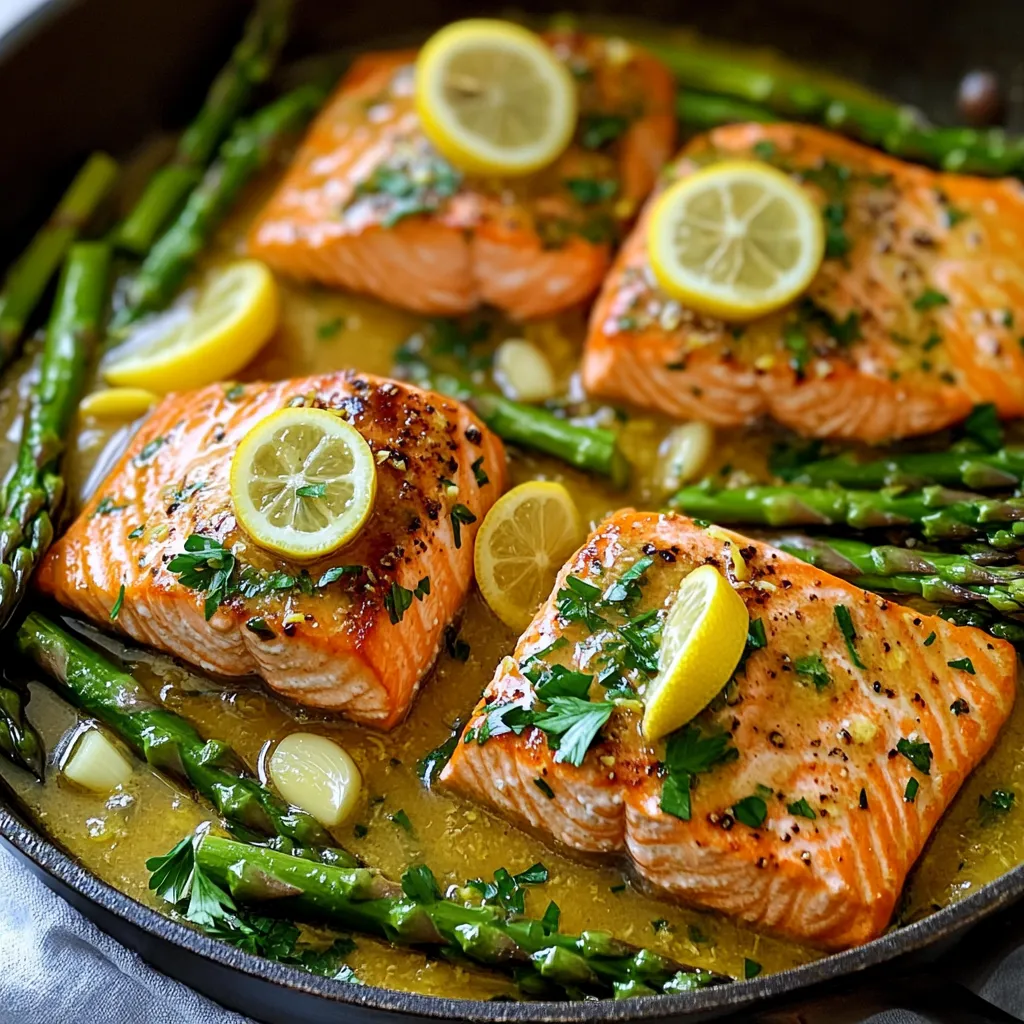Are you ready to create a dish that’s bursting with flavor? My Lemon Butter Salmon Asparagus Skillet is simple yet elegant. You’ll impress family or friends without breaking a sweat. This one-pan recipe combines fresh salmon, tender asparagus, and zesty lemon, all in under 30 minutes! Let’s dive into a delightful cooking experience that will leave taste buds dancing. Ready to make an unforgettable meal? Let’s get started!
Ingredients
List of Ingredients
- 2 salmon fillets (about 6 oz each)
- 1 bunch of asparagus, trimmed
- 3 tablespoons unsalted butter
- 2 tablespoons olive oil
- 3 cloves garlic, minced
- Zest of 1 lemon
- Juice of 1 lemon
- Salt and pepper to taste
- Fresh parsley, chopped (for garnish)
- Lemon slices (for garnish)
To make Lemon Butter Salmon Asparagus Skillet, you need a short list of fresh ingredients. Start with two salmon fillets, about six ounces each. Choose fillets that are firm and bright pink. Next, grab a bunch of asparagus. Trim the ends to keep it crisp and fresh.
You will also need butter for richness and olive oil for cooking. I like to use three tablespoons of unsalted butter for a creamy texture. Add two tablespoons of olive oil to help the salmon cook evenly.
Garlic adds a lovely flavor, so don’t skip the three cloves. Mince them finely for the best taste. For a bright pop, use the zest and juice of one lemon. This will bring a fresh taste to the dish.
Season with salt and pepper. You can adjust these to your liking. Finally, add some chopped fresh parsley for a nice touch on top. Lemon slices work well as a garnish too.
With these ingredients, you’re ready to make a delicious, healthy meal in no time!
Step-by-Step Instructions
Preparing the Skillet
- Heating the Olive Oil
Start by heating olive oil in a large skillet over medium-high heat. This step is key for a good sear on the salmon. You want the oil hot but not smoking.
- Searing the Salmon
Season the salmon fillets with salt, pepper, and lemon zest. Place them skin-side down in the skillet. Cook for 4-5 minutes without moving. This helps the skin get crispy.
- Adding Garlic and Asparagus
Carefully flip the salmon fillets. Add the minced garlic and trimmed asparagus to the skillet. Cook for 2-3 minutes more. The garlic will get fragrant, and the asparagus will start to soften.
Finishing Touches
- Incorporating Butter and Lemon Juice
Lower the heat to medium. Add the butter and lemon juice to the skillet. Spoon the melted butter and garlic over the salmon and asparagus. This adds a rich flavor that is hard to resist.
- Achieving Desired Salmon Cookedness
Continue cooking everything together for another 2-3 minutes. Check the salmon for your preferred doneness. The asparagus should be tender-crisp while the salmon stays moist.
Serving Suggestions
- Plating the Dish
Transfer the salmon and asparagus to a plate. Drizzle the lemon butter sauce from the skillet over the top. This adds a beautiful shine and flavor.
- Garnishing with Parsley and Lemon
To finish, sprinkle chopped parsley over the top. Add lemon slices for a pop of color. This not only looks great but also enhances the dish’s fresh taste.
Tips & Tricks
Cooking Tips
- Perfectly Crispy Salmon Skin
To get that nice, crispy skin, start with dry salmon. Pat it with paper towels. Season the skin side well. Place it skin-side down in the hot skillet. Don’t move it for 4-5 minutes. This helps the skin crisp up beautifully.
- Timing for Asparagus Tenderness
For tender asparagus, add it at the right time. After flipping the salmon, add the asparagus right away. Cook it for about 2-3 minutes. It should be bright green and still a bit crunchy.
Flavor Enhancements
- Optional Seasonings
Want to boost the flavor? Try adding dill or paprika. These spices can add a nice twist. Just sprinkle them on with salt and pepper.
- Alternative Garnishes
Instead of parsley, use chives or basil. You can also add capers for a salty kick. Lemon zest on top adds a fresh, bright taste.
Common Mistakes
- Overcooking the Salmon
Be careful not to overcook the salmon. Check it after 6-8 minutes total. It should flake easily with a fork but still be moist.
- Skipping the Marinating Step
Marinating is key for flavor. If you skip this, the dish may taste flat. A quick squeeze of lemon juice and some zest can make a big difference.

Variations
Ingredient Substitutions
Substitute for Salmon
If you want a different fish, try trout or cod. Both have mild flavors. They cook similarly to salmon and soak up the lemon butter well.
Alternative Vegetables
You can swap asparagus for green beans or broccoli. Both add crunch and color. You can also use zucchini, but cook it a bit less since it softens quickly.
Recipe Modifications
Adding Side Dishes
Pair this dish with rice or quinoa. They soak up the lemon butter sauce nicely. A simple mixed salad can add freshness and balance.
Adjusting Flavor Profiles
For a spicy kick, add red pepper flakes to the butter. If you love herbs, try adding dill or thyme. Both enhance the lemon’s zest.
Diet-Specific Adjustments
Gluten-Free Options
This dish is naturally gluten-free. Just ensure your sides, like rice, are also gluten-free. Check any packaged items for hidden gluten.
Dairy-Free Alternatives
Use coconut oil instead of butter for a dairy-free version. You can also try vegan butter. Both will keep the rich flavor while meeting dietary needs.
Storage Info
Storing Leftovers
Refrigeration Guidelines
You can store leftover lemon butter salmon and asparagus in the fridge. Place them in an airtight container. They are best eaten within two days. Make sure to cool them to room temperature before sealing. This keeps the flavors fresh and safe.
Freezing Instructions
For longer storage, you can freeze the leftovers. Wrap each portion tightly in plastic wrap. Then, place them in a freezer-safe bag. Label the bag with the date. They will stay good for up to three months. When you’re ready to eat, thaw them in the fridge overnight.
Reheating Tips
Best Methods to Reheat
The best way to reheat the salmon is in the oven. Preheat your oven to 350°F (175°C). Place the salmon on a baking sheet and cover it with foil. Heat for about 10-15 minutes. This keeps the salmon moist. You can also reheat it in a skillet over low heat.
Maintaining Texture
To keep the salmon and asparagus crisp, avoid the microwave. Microwaving can make the food soggy. If using the skillet, add a little olive oil when reheating. This helps restore some of the original texture. Always check that the salmon is heated through before serving.
FAQs
How do you know when salmon is done?
To check if salmon is done, look for visual signs. The flesh should change from bright pink to a pale, opaque color. The salmon will also flake easily with a fork. This shows it is cooked through.
You can also check the internal temperature. The safe temperature for cooked salmon is 145°F (63°C). You can use a meat thermometer to check this. Insert it into the thickest part of the fillet. If it reads 145°F, your salmon is ready!
Can you use frozen salmon for this recipe?
Yes, you can use frozen salmon. Just make sure to thaw it properly. The best way is to put it in the fridge overnight. If you need it fast, place it in a sealed bag and submerge it in cold water for about an hour. This prevents the salmon from becoming mushy.
What side dishes pair well with Lemon Butter Salmon?
Lemon butter salmon goes great with many side dishes. Here are some good choices:
- Garlic mashed potatoes
- Steamed rice
- Quinoa salad
- Roasted broccoli
- Mixed green salad
These sides will complement the flavors of the salmon and asparagus perfectly. Enjoy your meal!
This blog post covered easy steps to make Lemon Butter Salmon with asparagus. You learned about the key ingredients, cooking techniques, and tips for perfect results. Remember to adjust flavors to suit your taste. You can also explore variations for different diets. Proper storage and reheating maintain your dish’s quality. Now, you can enjoy a delicious meal that impresses everyone. Happy cooking!



